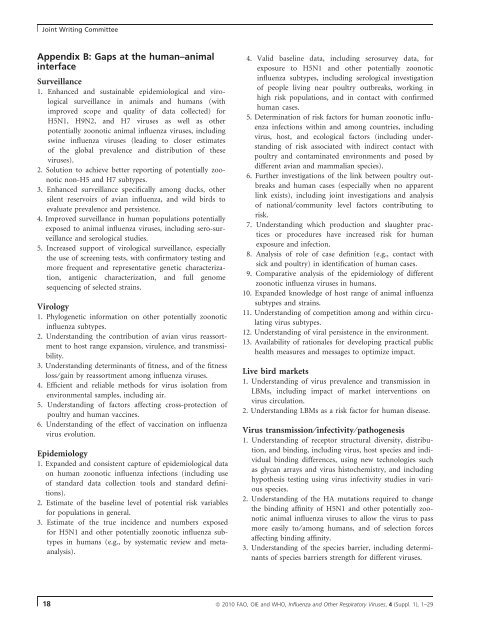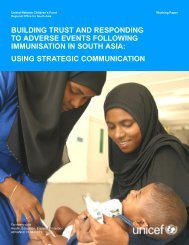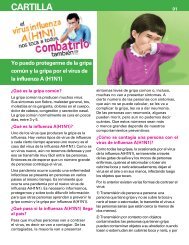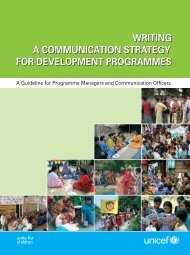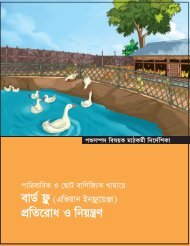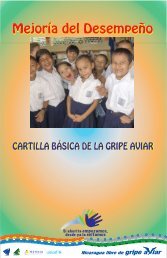FAO-OIE-WHO Joint Technical Consultation on Avian Influenza at ...
FAO-OIE-WHO Joint Technical Consultation on Avian Influenza at ...
FAO-OIE-WHO Joint Technical Consultation on Avian Influenza at ...
- No tags were found...
Create successful ePaper yourself
Turn your PDF publications into a flip-book with our unique Google optimized e-Paper software.
<str<strong>on</strong>g>Joint</str<strong>on</strong>g> Writing CommitteeAppendix B: Gaps <strong>at</strong> the human–animalinterfaceSurveillance1. Enhanced and sustainable epidemiological and virologicalsurveillance in animals and humans (withimproved scope and quality of d<strong>at</strong>a collected) forH5N1, H9N2, and H7 viruses as well as otherpotentially zo<strong>on</strong>otic animal influenza viruses, includingswine influenza viruses (leading to closer estim<strong>at</strong>esof the global prevalence and distributi<strong>on</strong> of theseviruses).2. Soluti<strong>on</strong> to achieve better reporting of potentially zo<strong>on</strong>oticn<strong>on</strong>-H5 and H7 subtypes.3. Enhanced surveillance specifically am<strong>on</strong>g ducks, othersilent reservoirs of avian influenza, and wild birds toevalu<strong>at</strong>e prevalence and persistence.4. Improved surveillance in human popul<strong>at</strong>i<strong>on</strong>s potentiallyexposed to animal influenza viruses, including sero-surveillanceand serological studies.5. Increased support of virological surveillance, especiallythe use of screening tests, with c<strong>on</strong>firm<strong>at</strong>ory testing andmore frequent and represent<strong>at</strong>ive genetic characteriz<strong>at</strong>i<strong>on</strong>,antigenic characteriz<strong>at</strong>i<strong>on</strong>, and full genomesequencing of selected strains.Virology1. Phylogenetic inform<strong>at</strong>i<strong>on</strong> <strong>on</strong> other potentially zo<strong>on</strong>oticinfluenza subtypes.2. Understanding the c<strong>on</strong>tributi<strong>on</strong> of avian virus reassortmentto host range expansi<strong>on</strong>, virulence, and transmissibility.3. Understanding determinants of fitness, and of the fitnessloss ⁄ gain by reassortment am<strong>on</strong>g influenza viruses.4. Efficient and reliable methods for virus isol<strong>at</strong>i<strong>on</strong> fromenvir<strong>on</strong>mental samples, including air.5. Understanding of factors affecting cross-protecti<strong>on</strong> ofpoultry and human vaccines.6. Understanding of the effect of vaccin<strong>at</strong>i<strong>on</strong> <strong>on</strong> influenzavirus evoluti<strong>on</strong>.Epidemiology1. Expanded and c<strong>on</strong>sistent capture of epidemiological d<strong>at</strong>a<strong>on</strong> human zo<strong>on</strong>otic influenza infecti<strong>on</strong>s (including useof standard d<strong>at</strong>a collecti<strong>on</strong> tools and standard definiti<strong>on</strong>s).2. Estim<strong>at</strong>e of the baseline level of potential risk variablesfor popul<strong>at</strong>i<strong>on</strong>s in general.3. Estim<strong>at</strong>e of the true incidence and numbers exposedfor H5N1 and other potentially zo<strong>on</strong>otic influenza subtypesin humans (e.g., by system<strong>at</strong>ic review and metaanalysis).4. Valid baseline d<strong>at</strong>a, including serosurvey d<strong>at</strong>a, forexposure to H5N1 and other potentially zo<strong>on</strong>oticinfluenza subtypes, including serological investig<strong>at</strong>i<strong>on</strong>of people living near poultry outbreaks, working inhigh risk popul<strong>at</strong>i<strong>on</strong>s, and in c<strong>on</strong>tact with c<strong>on</strong>firmedhuman cases.5. Determin<strong>at</strong>i<strong>on</strong> of risk factors for human zo<strong>on</strong>otic influenzainfecti<strong>on</strong>s within and am<strong>on</strong>g countries, includingvirus, host, and ecological factors (including understandingof risk associ<strong>at</strong>ed with indirect c<strong>on</strong>tact withpoultry and c<strong>on</strong>tamin<strong>at</strong>ed envir<strong>on</strong>ments and posed bydifferent avian and mammalian species).6. Further investig<strong>at</strong>i<strong>on</strong>s of the link between poultry outbreaksand human cases (especially when no apparentlink exists), including joint investig<strong>at</strong>i<strong>on</strong>s and analysisof n<strong>at</strong>i<strong>on</strong>al ⁄ community level factors c<strong>on</strong>tributing torisk.7. Understanding which producti<strong>on</strong> and slaughter practicesor procedures have increased risk for humanexposure and infecti<strong>on</strong>.8. Analysis of role of case definiti<strong>on</strong> (e.g., c<strong>on</strong>tact withsick and poultry) in identific<strong>at</strong>i<strong>on</strong> of human cases.9. Compar<strong>at</strong>ive analysis of the epidemiology of differentzo<strong>on</strong>otic influenza viruses in humans.10. Expanded knowledge of host range of animal influenzasubtypes and strains.11. Understanding of competiti<strong>on</strong> am<strong>on</strong>g and within circul<strong>at</strong>ingvirus subtypes.12. Understanding of viral persistence in the envir<strong>on</strong>ment.13. Availability of r<strong>at</strong>i<strong>on</strong>ales for developing practical publichealth measures and messages to optimize impact.Live bird markets1. Understanding of virus prevalence and transmissi<strong>on</strong> inLBMs, including impact of market interventi<strong>on</strong>s <strong>on</strong>virus circul<strong>at</strong>i<strong>on</strong>.2. Understanding LBMs as a risk factor for human disease.Virus transmissi<strong>on</strong> ⁄ infectivity ⁄ p<strong>at</strong>hogenesis1. Understanding of receptor structural diversity, distributi<strong>on</strong>,and binding, including virus, host species and individualbinding differences, using new technologies suchas glycan arrays and virus histochemistry, and includinghypothesis testing using virus infectivity studies in variousspecies.2. Understanding of the HA mut<strong>at</strong>i<strong>on</strong>s required to changethe binding affinity of H5N1 and other potentially zo<strong>on</strong>oticanimal influenza viruses to allow the virus to passmore easily to ⁄ am<strong>on</strong>g humans, and of selecti<strong>on</strong> forcesaffecting binding affinity.3. Understanding of the species barrier, including determinantsof species barriers strength for different viruses.18 ª 2010 <str<strong>on</strong>g>FAO</str<strong>on</strong>g>, <str<strong>on</strong>g>OIE</str<strong>on</strong>g> and <str<strong>on</strong>g>WHO</str<strong>on</strong>g>, <strong>Influenza</strong> and Other Respir<strong>at</strong>ory Viruses, 4 (Suppl. 1), 1–29


